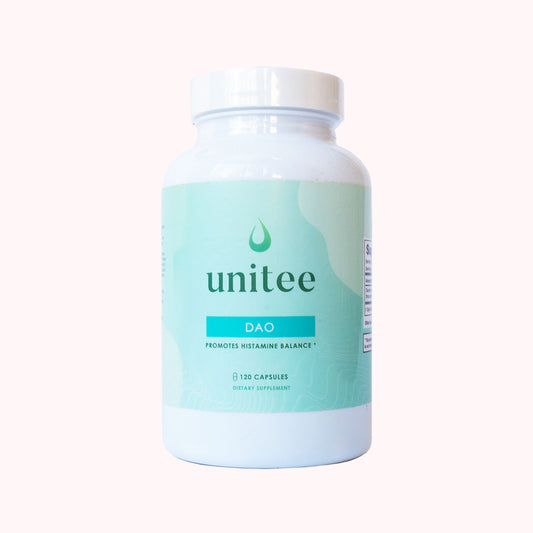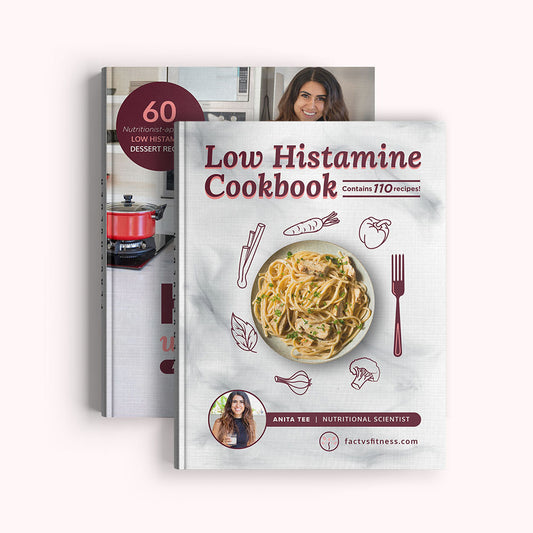Helping your doctor recognize and understand your histamine intolerance
Living with a histamine intolerance can be maddening.
It’s not just frustrating… it’s maddening.
What, with the long list of symptoms you couldn’t quite pinpoint - or still can’t! - to anything specific you ate or did, plus the brushing off you’ve had to endure trying to find a diagnosis to your condition.
You've researched how to handle the symptoms, but you’re still battling mainstream medicine, which claims you should take stronger antihistamines, constantly use your nose spray and even consider chronic cortisone use, to suppress your immune reactions.
While it might take a lot for you to keep at it, not give in, and continue to seek the appropriate treatment for your histamine intolerance, there is hope! It comes in the form of education and knowledge.
When you discuss your options with your doctor, understanding what might be going on in your body and addressing those concerns, may be just the thing that brings you closer to a resolution that works.
Histamine receptors and what they do
Let’s start with some of the basics. You already know that a variety of factors contribute to your histamine levels. Your immune system, medication, food you eat or even the status of your gut health can all play a role(1,2).
You’re also likely aware that the actions of histamine are most highly concentrated in the lungs, skin and gut, acting as a messenger chemical throughout your entire body - meaning the symptoms of histamine intolerance can be widespread.
Most histamine can be found in two important immune cells called mast cells and basophils. Histamine not located in these cells, will instead predominantly populate tissues in the stomach lining, lymph nodes and thymus gland. Much smaller amounts are found in the liver, lung and brain tissues(3).
What you may not know, however, is how you become histamine intolerant in the first place, and why it causes the symptoms that it does.
This information should help you to better identify where your histamine load is coming from, and why those antihistamines you’ve been taking for so long simply don’t work as they should. To understand this, we’re going to talk about histamine receptors for a minute.
The science of histamine intolerance
The histamine receptors in question are located on various cells that, when histamine locks into them, elicit a specific response. There are four receptors, conveniently labelled H1-H4, which spread throughout the body depending on what histamine reaction is caused, and where(4).
The H1 and H2 receptors are extremely important to understand - they're associated with cells responsible for immunity and immune response. H1 and H2 are located throughout the brain, muscles, gut and respiratory tissues.
The brain you say? That's right, the activation of H1 receptors in the brain stimulate our neurons. This is why higher histamine levels often result in anxiety, nervousness, irritability, aggression and sleep disorders.
We typically target this with the classic antihistamine drugs; they act by blocking brain tissue overstimulation. While this can work, you're probably familiar with the side effects - drowsiness/sedation(5).
A histamine response via the stimulation of H1 receptors has been shown to increase the permeability of blood vessels, as well as the release of a whole whack of chemicals throughout the body. This is what results in the wide range of symptoms you're more than familiar with.
There’s also evidence to suggest that the activation of the H1 receptors in the adrenal glands and lymphocytes can cause a predisposition to autoimmune encephalomyelitis (ME/CFS) and multiple sclerosis (MS)(6).
What about H2 medication? Well, H2 receptor blockers are said to have revolutionized the clinical treatment of stomach acid-related disorders(7,8).
It’s drugs that block only these first two receptors that have been approved for use in humans - you’ll soon see why they don’t work as well as they should!
Why medications fall short on treating high histamine levels
Studies have shown that H1 and H2 receptors actually bind histamine far less than the H3 and H4 receptors. So, does this mean that when H1 and H2 receptors are being blocked, your high histamine is binding strongly to H3 and H4 receptors, anyway? It very well might.
And it could be why you’re still super anxious, struggling to sleep and still reacting with a bunch of symptoms, despite the meds best efforts only controlling the sneezing, runny nose and itchy eyes.
You see, the H3 receptor is an interesting one, and it manifests itself in psychological symptoms more than the other three. We know that H3 is a regulator of histamine synthesis(9), but, there’s new evidence to suggest that blocking the H3 receptor results in improved brain function and cognition(10).
There are no H3 blocking drugs on the market for this yet, and testing is still in the early phases, but H3 blocking drugs are currently being used to treat sleep/wake disorders(11).
Not much is known about the most recently discovered histamine receptor, H4. There is conflicting evidence on where in the body H4 is most prevalent, and what its role is. However, what has conclusively been determined is that it plays a significant role in the inflammatory process of immune-mediated diseases(12).
So, what are your options when it comes to treatment?
How to manage your histamine levels
One of the best ways to manage all of the symptoms excess histamine creates, is to reduce the histamine levels in your body. You can do that by:
- Eating a low histamine diet (reduced histamine intake, thus reducing the blocking of DAO and liberation of histamine from the body)(13). For a comprehensive list of foods to eat and restrict when reducing histamine symptoms,
click below to receive your free copy of Low Histamine Diet Guide.
- Take the right probiotic to help to balance the histamine-producing bacteria in your gut.
- Improve your body’s tolerance to histamine, by stimulating its own processing/breakdown mechanism (through the enzyme diamine oxidase (14), for example). You can ask your doctor to try a type of histamine intolerance test, such as a DAO test, to determine if DAO deficiency is an underlying cause of your condition.
- Try adding supplements that are proven to be effective histamine intolerance aids, such as supplementing DAO enzymes and an all-natural antihistamine
Even if you do continue to use the traditional H1 or H2 blocking medications, it is still essential to reduce the overall load of histamine in your body, and minimise the stimulation of the other receptors.
Knowledge is your best weapon against disease. When you speak to your doctor about your symptoms and condition, understanding the cause and affects on you as an individual, can allow for a more relevant and productive conversation and strategy for the management of your condition.
References
- E.Kovacova-Hanuskova., et al. Histamine, histamine intoxication and intolerance. Allergologia et Immunopathologia. Volume 43, Issue 5, September–October 2015, Pages 498-506. https://www.sciencedirect.com/science/article/pii/S0301054615000932
- Barcik, W., et al. Immune regulation by histamine and histamine-secreting bacteria. Current Opinion in Immunology. Volume 48, October 2017, Pages 108-113. https://www.sciencedirect.com/science/article/pii/S0952791517300535
- Zimmermann AS, Burhenne H, Kaever V, Seifert R, and Neumann D (2011) Systematic analysis of histamine and N-methylhistamine concentrations in organs from two common laboratory mouse strains: C57Bl/6 and Balb/c. Inflamm Res 60:1153–1159. https://link.springer.com/article/10.1007/s00011-011-0379-5
- Haas HL, Panula P (2016) Histamine receptors. Neuropharmacology 106:1–2. https://www.sciencedirect.com/science/article/pii/S0028390816301435?via%3Dihub
- Parmentier R, Ohtsu H, Djebbara-Hannas Z, Valatx JL, Watanabe T, and Lin JS (2002) Anatomical, physiological, and pharmacological characteristics of histidine decarboxylase knock-out mice: evidence for the role of brain histamine in behavioral and sleep-wake control. J Neurosci 22:7695–7711. https://www.jneurosci.org/content/22/17/7695?ijkey=9c060f89084a4f50e050d7d362769d2912a294ae&keytype2=tf_ipsecsha
- Saligrama N, Noubade R, Case LK, del Rio R, and Teuscher C (2012) Combinatorial roles for histamine H1-H2 and H3-H4 receptors in autoimmune inflammatory disease of the central nervous system. Eur J Immunol 42:1536–1546. https://www.ncbi.nlm.nih.gov/pubmed/22678907?dopt=Abstract
- Jutel M, Akdis M, and Akdis CA (2009) Histamine, histamine receptors and their role in immune pathology. Clin Exp Allergy 39:1786–1800. https://www.ncbi.nlm.nih.gov/pubmed/20085595?dopt=Abstract
- Sigterman KE, van Pinxteren B, Bonis PA, Lau J, and Numans ME (2013) Short-term treatment with proton pump inhibitors, H2-receptor antagonists and prokinetics for gastro-oesophageal reflux disease-like symptoms and endoscopy negative reflux disease. Cochrane Database Syst Rev 5:CD002095. https://www.ncbi.nlm.nih.gov/pubmed/23728637?dopt=Abstract
- Hill SJ, Ganellin CR, Timmerman H, Schwartz JC, Shankley NP, Young JM, Schunack W, Levi R, and Haas HL (1997) International Union of Pharmacology. XIII. Classification of histamine receptors. Pharmacol Rev 49:253–278. https://pharmrev.aspetjournals.org/content/49/3/253?ijkey=559edda3faa45545e6c463225c3b3569f112c38d&keytype2=tf_ipsecsha
- Munari L, Provensi G, Passani MB, and Blandina P (2013) Selective brain region activation by histamine H₃ receptor antagonist/inverse agonist ABT-239 enhances acetylcholine and histamine release and increases c-Fos expression. Neuropharmacology 70:131–140. https://www.ncbi.nlm.nih.gov/pubmed/23380305?dopt=Abstract
- Femenia T Magara S DuPont CM Lindskog M (2015) Hippocampal-dependent antidepressant action of the H3 receptor antagonist clobenpropit in a rat model of depression. Int J Neuropsychopharmacol. https://www.ncbi.nlm.nih.gov/pubmed/25762718
- Gantner F, Sakai K, Tusche MW, Cruikshank WW, Center DM, and Bacon KB (2002) Histamine h4 and h2 receptors control histamine-induced interleukin-16 release from human CD8+ T cells. J Pharmacol Exp Ther 303:300–307. https://jpet.aspetjournals.org/content/303/1/300?ijkey=9c87b47be51576b8a70bd40f4dcb166fee99cf98&keytype2=tf_ipsecsha
- Schwelberger HG. Histamine intolerance: a metabolic disease? Inflamm Res. 2010;59 Suppl. 2:S219---21. https://www.ncbi.nlm.nih.gov/pubmed/20012758
- Schwelberger, H. The origin of mammalian plasma amine oxidases. J Neural Transm (2007) 114: 757. https://link.springer.com/article/10.1007/s00702-007-0684-x#citeas







